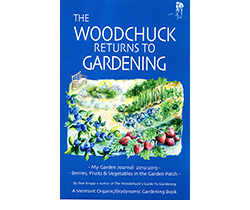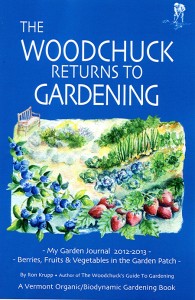
 copyright the Chronicle December 23, 2014
copyright the Chronicle December 23, 2014
The Woodchuck Returns to Gardening, by Ron Krupp. Published by Whetstone Books. Paperback. 247 pages. $18.
Reviewed by Tena Starr
Yes, it will be months before we see anything besides a Christmas tree that’s green, but it’s never too early to start thinking about spring gardening. Seed catalogues will start arriving in January, and gardeners will pore over them, planning for the coming summer harvest.
The Woodchuck Returns to Gardening is a follow-up to Ron Krupp’s The Woodchuck’s Guide to Gardening, and it has sound advice about seeds. Not surprisingly, Mr. Krupp heavily relies on many of the old standbys that have stood the test of time, such as Provider green beans.
This is a meandering little book, part garden journal, part encyclopedia with commentary, anecdotes, and historical information.
I was surprised to learn that orange carrots weren’t common until the 1700s when the Dutch popularized them. Before that, the red and white varieties were generally grown. They’re pretty but tasteless.
Mr. Krupp chronicles the weather and the progress of his garden in 2012 and 2013. The second half of the book is a discussion of how to grow and harvest a variety of vegetables, listed in alphabetical order.
The book isn’t written for advanced gardeners, it’s more of a primer for latecomers to organic gardening. But it has tidbits that anyone might find useful, and Mr. Krupp’s running, often wry, commentary is frequently amusing. His alter ego is “the Chuckster,” who wonders why Ron Krupp continues to dig in the dirt every spring.
“Well, all I can say to the Chuckster is that I’ve been doing this for more than 49 years, and I’d be lost if I couldn’t dig in the soil and plant seeds,” Mr. Krupp replies. “It’s in my bones. Perhaps it’s a karmic thing. When I die, I hope it happens in the garden as the sun is setting.”
Although Mr. Krupp lives in the Champlain Valley, which has a milder climate than the Northeast Kingdom, I can certainly relate to his relationship with the month of March.
“March always tests my patience as I’m ready to get going in the garden,” he writes. “It’s a tough month for all occupants of the earth. If you’re a woodchuck gardener, you might be tempted to push the season a bit and plant seeds in the earth too early. Just make sure the soil is crumbly, not wet. If it holds together in heavy clumps, it’s still too wet. Put your bare hand into the soil to test how cold it is. If it’s real cold, it’s not time to plant.”
Those 49 years of gardening have provided Mr. Krupp with a wealth of experience, which he passes on here in a chatty style. He offers advice on what to plant, when to plant, and recipes for organic pest control.
He is not big on recipes for what to do with the food you harvest, though. He doesn’t have much more patience for writing down recipes than he does for the month of March.
For instance, he says there’s nothing better than roasted squash and spinach quiche.
“The Chuckster wanted to know why I don’t share the recipes for roasted squash and quiche. I told him to simply place the whole squash in the oven and let it bake. It’s not rocket science. Go online for a spinach quiche recipe and toss in some roasted squash. And anyway, it takes too much room to provide those long recipes. Or maybe I’m just lazy.”
There’s also useful advice on storing root vegetables. No, you don’t have to have a root cellar. Mr. Krupp recommends five-gallon buckets. Actually, he recommends five-gallon buckets for a lot of things.
In 2012, in early November, he stored his carrots, leeks, beets, turnips, celeriac, and cabbages outside in buckets covered with hay and old rugs. In mid-November he mixed slightly damp sand with the root crops in the buckets and put them in the cool part of his cellar. Fine wood shavings can be used instead of sand.
“The cellar has a high moisture content, which is ideal for storing root crops,” Mr. Krupp writes.
If you want to store carrots and other root crops in the refrigerator, cut off the tops and brush off most of the dirt — but not all of it because a little bit of soil helps carrots resist decay. Carrots will last about three months in the refrigerator; beets and turnips will last longer.
As for those five-gallon, plastic buckets: “I harvest my vegetables, carry buckets of compost to spread on the garden beds, and cart tools around in them. At home, I store root crops in buckets in the cellar as I mentioned above. I carry wood in them from the woodpile in the backyard. Yesterday, I weeded garden beds at Anna’s garden and placed the weeds in five-gallon buckets. I could go on and on but you’ll get bored.”
One of my favorite chapters is about beets, maybe because I’m fond of beets, and Mr. Krupp clearly is, too.
Traditionally, in New England, beet greens were eaten in late spring and early summer as a mineral tonic after the long winter, Mr. Krupp writes.
He recommends Early Wonder Tall Top, introduced in 1911, as a particularly early and productive variety.
“In 35 days, you’ll be sitting down to a mess of baby beet greens chock full of so many minerals you can taste them.”
Mr. Krupp also provides simple pickling methods and salad ideas. (No recipes, of course, just a kind of basic outline.)
The book also includes chapters on berries and fruit trees, with sound advice about varieties, how to plant, how to thin, and how to maintain.
Mr. Krupp has written a sound gardening book, one that any gardener could happily add to his or her library. And it’s an easy, folksy read.
contact Tena Starr at [email protected]
For more free articles from the Chronicle like this one, see our Reviews pages. For all the Chronicle’s stories, subscribe:
Print subscription
Annual online subscription
Short-term online subscription







